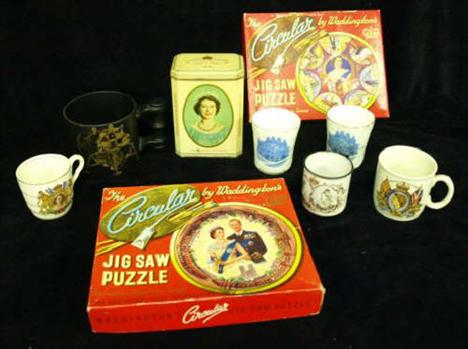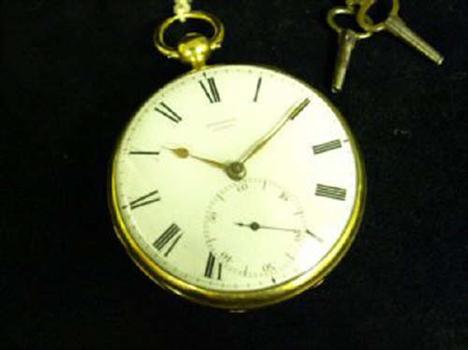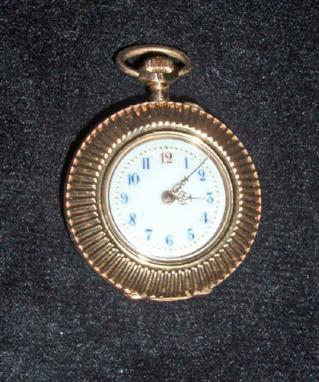396323 Preisdatenbank Los(e) gefunden, die Ihrer Suche entsprechen
396323 Lose gefunden, die zu Ihrer Suche passen. Abonnieren Sie die Preisdatenbank, um sofortigen Zugriff auf alle Dienstleistungen der Preisdatenbank zu haben.
Preisdatenbank abonnieren- Liste
- Galerie
-
396323 Los(e)/Seite
A. G.Naughten. A gentleman's 18ct gold keyless lever hunter pocket watch, the circular white enamel dial with Roman numerals and subsidiary seconds dial in a plain 18ct gold case, the movement with bi-metallic compensated balance, engraved cock with ruby endstone, the three-quarter backplate inscribed 'A G Naughton, Edinburgh 30617'.
A 19th century bronzed metal and gilt metal mounted mantel clock, the case surmounted by a mediaeval monarch on horseback, the base with polished marble rectangular panels enclosed by gilt metal mounts of flowers foliage and military trophies, having a 9.5cm. enamel dial signed 'Ducas, Paris', the twin cylinder circular movement with outside striking to a bell, on an oval ebonised plinth base and contained under a glass dome, 56cm. high.
The following twelve lots are from the collection of the late Hon. Mrs Nellie Ionides: An English enamel 'Rainbow Group' scent bottle, Bilston circa 1765, of shaped rectangular form, transfer printed and painted a harbour scene and a street scene, on a polychrome ground with raised white and gilt ornament, the stopper lacking, 6cm (2.25") high (see illustration)
Army Temperance Association, India medals: A.T.A.I.1 (3); A.T.A.I.2 (2) - one with ‘Fidelity’ brooch bar; A.T.A.I.3 (4) - one with ‘Excelsior’ brooch bar; A.T.A.I.5 (2), one with slight enamel damage; Army Temperance Association, Home medals: A.T.A.H.2 (3); A.T.A.H.13; Royal Army Temperance Association medals: R.A.T.A.1 (2), some with edge bruising, very fine and better (17) £70-90.
Borough of Portsmouth Tribute Medal, 27mm., silver and enamel, hallmarks for Birmingham 1902, rev. impressed, ‘Naval Brigade, South Africa 1899-1900, North China 1900’, ref. Hibbard A21, rev. 2, lacks suspension ring; Presentation Silver Box, circular, approx. 70mm. dia., hinged lid engraved with the shield of ‘Lloyds’ and inscribed, ‘Lloyd’s 7th May 1900’, hallmarks for Birmingham 1899, first very fine; last in good condition (2) £180-220 A label affixed to the box reads, ‘Presentation box to H.M.S. Powerful re. S.A. War at Portsmouth Town Hall April 1900’.
Sheriff of Kent Badge, 23mm., silver-gilt, silver and enamel, hallmarks for London 1937, reverse inscribed, ‘Major Sir John Theodore Prestige, High Sheriff of Kent, 1931-32’, with enamelled brooch bar, ‘1931-32’. in fitted case of issue, good very fine £60-80 Major Sir John Theodore Prestige was born in 1884. During the Great War he was an officer employed in recruiting duties with the 20th Battalion London Regiment and was a representative member on the L.C.C. Territorial Force Association. In 1918 he contested the Deptford Constituency as a Unionist and in 1919 was knighted. Prestige was High Sheriff of Kent during 1931-32. He died in 1962.
The Second World War St. Nazaire raid V.C. group of eleven attributed to Lieutenant-Colonel A. C. Newman, Essex Regiment, attached No. 2 Commando Victoria Cross; The Most Excellent Order of the British Empire, M.B.E. (Civil) Member’s 2nd type; 1939-45 Star; France and Germany Star; Defence and War Medals, M.I.D. oak leaf; Coronation 1937; Coronation 1953; Efficiency Decoration, G.VI.R., with 2 Bars; French Legion of Honour, silver, gilt and enamel; French Croix de Guerre, with palm, mounted as worn, the Coronation awards with reversed ribands, very fine or better (11) £600-800 Ex Spink, 17 July 1997 (Lot 850), when part of a ‘fine collection of miniature medals’. Augustus Charles Newman was awarded his V.C. for outstanding bravery in the famous raid on St. Nazaire in March 1942, when, as Commanding Officer of the military forces, he was one of the first ashore, leading his men and directing operations, quite regardless of his own safety. He later attempted to fight through to open country and not until all ammunition was expended were he and his men overwhelmed and taken prisoner (see the London Gazette 19 June 1945 for full details); sold with a copy of The Art of Jack Russell, with a signed dedication to Newman’s bravery at St. Nazaire, together with a photocopy of his lengthy handwritten report on the raid, written as a P.O.W.
The Order of St. John of Jerusalem (3), Knight of Grace set of insignia, neck badge, 54 x 54mm. and breast star, 70 x 70mm., silvered base metal and enamel, neck badge with replacement suspension, one arm with enamel damage; star with one bruised point and slight enamel damage; another, Serving Brother, silver and enamel; with dress miniature; Jubilee 1935, with dress miniature; Coronation 1937 (2); Coronation 1953; miscellaneous Italian medals (3), nearly very fine and better (12) £140-160.
Imperial Service Medal (7), G.V.R., 2nd issue (Alfred Edward Elkington); G.V.R., 3rd issue (Edward Hems Groom); G.VI.R., 1st issue (Henry Sharp); G.VI.R., 2nd issue (George Nicholas Chadwick; George Arthur Mitchell); E.II.R., 1st issue (Lawrence Joseph Francis Gatt); E.II.R., 2nd issue (Denver Redfern Thomas) last two in case of issue; Pair: Corporal W. Stockton, St. John Ambulance Brigade, Order of St. John, Serving Brother, silver and enamel, unnamed, with silver ‘St. John’ bar; St. John Service Medal (13502 Cpl. W. Stockton, Chester Div. No.4 Dis. S.J.A.B. 1935) in case of issue; together with a miniature Serving Sister badge, silver and enamel; St. John Service Medal (30951 A/Sts. E. M. Smith, London S.J.A.B. 1944); St. John Re-Examination Cross (2) (A70754 Beppa Sharkey) in case of issue; another (131712 George Seed) with 17 date bars; British Red Cross Society War Medal 1914-18; British Red Cross Society L.S. Medal, for 3 Years, enamelled, in card box; Q.A.I.M.N.S.R. Cape Badge, silver, hallmarks for Birmingham 1915; Pakistan medals (6), generally good very fine and better (22) £100-140 British Red Cross Society L.S. Medal with award slip to ‘Miss Kathleen V. Fitzgerald’, dated 26 June 1945. 591.5. The Orders and Decorations of General Sir Hilgrove Tomkyns Turner, G.C.H., K.C., Colonel of the 19th Regiment, onetime Lieutenant-Governor of Jersey and of Bermuda, soldier and courtier under Kings George III and George IV, who secured the Rosetta Stone for England in 1801, and acted as guide to Czar Alexander of Russia and to his sister The Grand Duchess of Oldenburg on their tour of England in 1814. Sold by Order of a Direct Descendant.591.5. Tomkyns Hilgrove Turner was born in 1764, and was appointed Ensign in the Third Foot Guards on 20 February 1782. He was promoted to be Lieutenant and Captain on 13 October 1789. He went to Holland in February 1793 with the brigade of guards under Frederick, Duke of York, landed at Helvoetsluys on 5 March, Marched to Tournay, in May camped at Maulde, took part in the battle of St Amand on 8 May, the action of Famars on 23 May, the siege of Valenciennes in June and July, the assault of that place on 25 July, and its capitulation on the 28th. In August Turner marched with the British force to lay siege to Dunkirk, and on the way was present at the brilliant affair at Lincelles on 18 August, when the guards at the point of the bayonet drove out of a village and of an entrenched position a superior body of French who had previously captured them from the Dutch. He was engaged in the siege of Dunkirk and in the repulse of sorties, on 6 and 8 september, the latter at Rosenda‘l, but the covering army having been compelled to by Houchard to retire to Furnes, the Duke of York was obliged to raise the siege, and Turner marched with the guards to Cysoing, between Lille and Orchies. On 5 October the British guards joined the Austrians across the Sambre for the investment of Landercy, but the siege was not prosecuted, and Turner, repassing the Sambre with his regiment, marched to Ghent. On 17 April 1794, Turner was engaged at Vaux in the successful attack by the allies on the French army posted between Landrecy and Guise, when it was driven behind the Oise and Landrecy invested. He was present in several affairs during the siege, and was at the action of Cateau, near Troixville, on 26 April, after which he went with the Duke of York’s army to Tournay and took part in the repulse of the French attack on 11 May and subsequent actions during the same month. He accompanied the army in its retreat towards Holland in July and behind the Aa in September, took part in the fight at Boxtel on 15 September, and in the retreat behind the Meuse to Nimeguen. He greatly distinguished himself at the capture of Fort St AndrŽ, under Abercromby, and accompanied the army in the retreat behind the Waal. Turner was promoted to be Captain in the 3rd Foot Guards and Lieutenant-Colonel on 12 November 1794, when he appears to have returned to England. He was promoted to be brevet Colonel on 1 January 1801, in which year he went with his regiment to Egypt, landing at Aboukir Bay on 8 March, when he was engaged with the enemy. He took part in the action of 13 March, and in the battle of Alexandria on 21 March. He was also in the action on the west side of Alexandria on 2 September. For his services in Egypt he was made a Knight of the Order of the Crescent by the Sultan of Turkey. By the terms of Article 6 of the capitulation of Alexandria, all the curiosities, natural and artificial, collected by the French Institute were to be delivered to the victors. The French sought to evade the article on the ground that the collections were all private property, and General Menou claimed as his own the Rosetta stonefound by the French in 1798 when repairing the ruined Fort St Julien, and deposited in his house at Alexandria. Turner, who was a great antiquary, was deputed by Lord Hutchinson to negotiate on the subject, and, after much correspondence and several conferences with General Menou, it was decided that, considerable care having been bestowed by the French in the preservation of the collection of insects and animals, these should be retained, but the antiquities and Arabian manuscripts Lord Hutchinson insisted should be given up. The French were very angry, and broke the cases and removed the protecting coverings of many of the antiquarian treasures. Turner obtained a party of gunners and a ‘devil’ cart, with which he carried off the Rosetta stone from General Menou’s house amid the jeers of the French officers and men. These gunners were the first British soldiers to enter Alexandria. Having seen the other remains of ancient Egyptian sculpture sent on board the Madras, Admiral Sir Richard Bickerton’s ship, Turner embarked with the Rosetta stone on board the Egyptienne frigate, and arrived at Portsmouth in February 1802. At Turner’s request, Lord Buckinghamshire, secretary of state, allowed the stone to be sent first to the Society of Antiquaries, where it remained for a little while before being deposited in the British Museum. In January 1803 Turner communicated to the Society of Antiquaries a version of the inscription on Pompey’s Pillar, taken by Captain Dundas, Royal Engineers. In July 1803 Turner was appointed an Assistant Quartermaster-General to the forces in Great Britain, and on 25 June 1804 a Brigadier-General on the staff at home. In April 1807 he was transferred as a Brigadier-General to the staff in South America, where, it is thought, he was intended by the Government to become the first British Governor of the Spanish South American possessions, the capture of these being the objective of the military expeditions in 1806-07. However, with the humiliating defeat of General Whitelocke before Buenos Aires and the subsequent withdrawal from Montivideo, by the time of Turner’s arrival in South America in December 1807 all prospect of conquest had disappeared and with it all prospects of his governorship. Turner, who had been accompanied to South America by his wife and two of his four children, returned to England via the Cape of Good Hope in the spring of 1808 and was promoted to be Major-General on 25 April that same year. General Turner was a servant of the courts of three successive monarchs, comprising George III and his two sons. Under what auspices, with what influence and exactly at what period of his career he began his intimacy with the court of George III is not known. From 1803 he was Assistant Quartermaster-General of the Home District under Prince Adolphus Frederick, Duke of Cambridge, youngest son of George III, with whom Turner seems to have developed a very close friendship. In 1809 he was appointed Gentleman attendant to H.R.H. the Prince of Wales, whom he accompanied on his visits to Brighton, and in 1811, when the Prince became Regent, he was appoi
The Royal Guelphic Order, G.C.H. (Civil) Knight Grand Cross collar chain and sash badge, circa 1830-35, the silver-gilt chain comprising 24 alternating Guelphic crowns, lions passant and reversed cyphers of King George III, unmarked but of fine quality and contained in its original fitted red leather case; the superb sash badge in gold and enamels, 112mm x 74mm excluding suspension ring, some enamel loss to both wreaths, otherwise good very fine and rare £6000-8000 General Turner was promoted to Knight Grand Cross (Military) in 1827.
-
396323 Los(e)/Seite














































